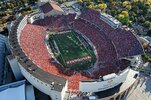I think that if you go by stadium sizes (dedicated, non-shared facilities), you can get pretty damn close to the list of schools with the commitment, resources and fan base to build your top tier football division. I'm only listing schools which are or were in the ACC, Big 12, Big Ten, Pac-12 and SEC, plus Notre Dame.
1. Michigan (107,600)
2. Penn State (106,562)
3. Ohio State (102, 780)
4. Texas A&M (102,733)
5. LSU (102,321)
6. Tennessee (101,915)
7. Texas (100,119)
8. Alabama (100,077)
9. Georgia (93,033)
10. UCLA (92,542)
11. Nebraska (90,000)
12. Florida (88,548)
13. Auburn (88,043)
14. Clemson (81,500)
15. Oklahoma (80,126)
16. Florida State (79,560)
17. Notre Dame (77,622)
18. South Carolina (77,599)
19. USC (77,500)
20. Arkansas (76,212)
21. Wisconsin (75,822)
22. Michigan State (75,005)
23. Iowa (70,585)
24. Washington (70,083)
25. Pitt (68,400) - shared with Steelers
26. Virginia Tech (65,632)
27. Miami (64,767) - shared with Dolphins
28. Ole Miss (64,038)
29. BYU (63,470)
30. Cal (62,467)
31. Missouri (61,620)
32. Iowa State (61,500)
33. Virginia (61,500)
34. Purdue (61,441)
35. Mississippi State (61,337)
36. Kentucky (61,306)
37. Louisville (60,800)
38. Illinois (60,670)
39. Texas Tech (60,229)
40. West Virginia (60,000)
41. NC State (58,000)
42. Arizona State (56,634)
43. Oklahoma State (55,509)
44. Georgia Tech (55,000)
45. Oregon (54,000)
46. Indiana (52,626)
47. Rutgers (52,454)
48. Maryland (51,802)
49. Utah (51,444)
50. Minnesota (50,805)
51. North Carolina (50,500)
52. Colorado (50,183)
53. Kansas State (50,000)
54. Stanford (50,000)
55. Syracuse (49,057)
56. Baylor (45,140)
57. TCU (45,000)
58. Boston College (44,500)
59. UCF (44,206)
60. Kansas (40,000) - estimate after renovation
61. Vanderbilt (39,790)
62. Cincinnati (38,088)
63. Oregon State (35,548)
64. Northwestern (35,000)
65. Washington State (32,952)
66. SMU (32,000)
67. Wake Forest (31,500)

en.wikipedia.org
Not that this is the be all and end all for realignment, but it matters. Assuming only $100 per ticket, every 10k in capacity represents an increase of $1M in base revenue per game. When you figure concessions, parking and the fact that the average ticket price is more than $100, the program revenue differentials quickly get into the tens of millions per year just based on this. CU needs to get Folsom to over 60,000 (I'd like 65k for the optics of having the largest stadium in the Big 12). And, frankly, once you get below 70k (Washington at #24), it's slim pickings of teams that can legitimately compete to win a national championship. And how many of the programs below #24 actually move the needle for viewership? Is 32, like the NFL, the right number? I tend to think that college football is different and the number is probably 48.



